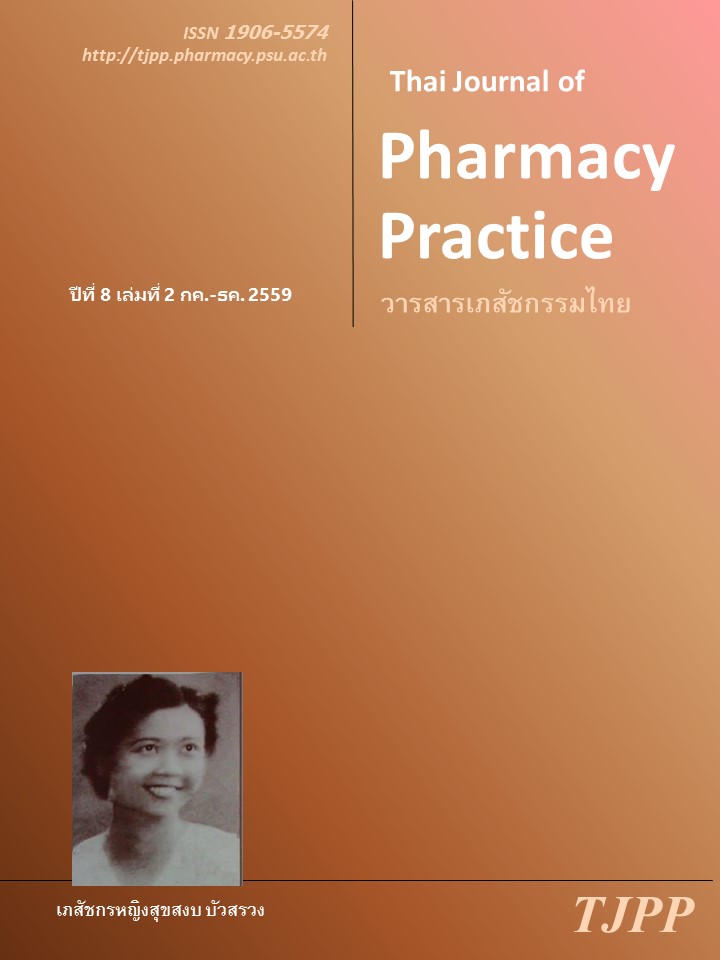การใช้ยาปฏิชีวนะในฟาร์มปศุสัตว์: กรณีศึกษาจังหวัดเชียงใหม่
Main Article Content
บทคัดย่อ
วัตถุประสงค์: เพื่อสำรวจพฤติกรรมการใช้ยาปฏิชีวนะในฟาร์มปศุสัตว์ในอำเภอแม่ออน จังหวัดเชียงใหม่ วิธีการวิจัย: การสัมภาษณ์แบบมีโครงสร้างในกลุ่มตัวอย่างเกษตรกรผู้เลี้ยงสัตว์จำนวนทั้งสิ้น 100 ราย ในช่วงเดือนกันยายนถึงเดือนตุลาคม 2558 การศึกษาเลือกกลุ่มตัวอย่างแบบสะดวก ผลการวิจัย: กลุ่มตัวอย่างเกษตรกรร้อยละ 76 ประกอบอาชีพเลี้ยงโคนม สัตว์อื่นๆ ที่พบว่ามีการเลี้ยง ได้แก่ สุกร โคเนื้อ ไก่พื้นเมือง ไก่ไข่ และกระบือ ในสัตว์ทุกประเภทที่ศึกษา เกษตรกรผู้เลี้ยงสัตว์มากกว่าร้อยละ 80 มีการใช้ยาปฏิชีวนะ พบว่ามีการใช้ยาปฏิชีวนะตลอดวงจรการเลี้ยงสัตว์ รวมถึงใช้ในข้อบ่งใช้เพื่อการรักษาโรค ป้องกันโรค และเร่งการเจริญเติบโตในสัตว์ด้วย ยาปฏิชีวนะที่พบว่ามีการใช้มากที่สุดในการเลี้ยงสัตว์ คือ oxytetracycline (ร้อยละ 57) ผู้ให้ยาปฏิชีวนะแก่สัตว์ส่วนใหญ่เป็นเกษตรกรเองไม่ใช่บุคคลากรที่มีความรู้เกี่ยวกับยาปฎิชีวนะ เกษตรกรมีพฤติกรรมการใช้ยาปฏิชีวนะอย่างไม่สมเหตุผลหลายกรณี ได้แก่ ใช้ไม่ตรงตามข้อบ่งใช้และใช้มากเกินจำเป็น เช่น การใช้ยา colistin เพื่อเป็นวิตามินบำรุงลูกสุกร เนื่องมาจากเกษตรกรรับรู้ว่า ยาปฏิชีวนะดังกล่าวคือวิตามินบำรุงสัตว์ นอกจากนี้มีการใช้ยาปฏิชีวนะในขนาดต่ำๆ เป็นระยะเวลานาน ซึ่งอาจก่อให้เกิดปัญหาเชื้อดื้อยาได้ เช่น การใช้ยา oxytetracycline ตลอดช่วงวงจรการเลี้ยงโคนม โดยมีการใช้ตั้งแต่ใช้เพื่อรักษาบาดแผลและการอักเสบในลูกโคนม อาการอักเสบจากการลื่นล้ม หรือภาวะเต้านมอักเสบในโคนมโตเต็มวัย รวมถึงใช้เพื่อป้องกันภาวะอักเสบหลังจากการคลอดของแม่โคนม เป็นต้น เกษตรกรส่วนใหญ่มีความรู้ในระดับปานกลางเกี่ยวกับการใช้และผลกระทบจากการใช้ยาปฏิชีวนะในเกษตรกรรมการเลี้ยงสัตว์ เกษตรกรส่วนใหญ่ยังไม่แน่ใจว่า การใช้ยาปฏิชีวนะในเกษตรกรรมการเลี้ยงสัตว์ทำให้เกิดการตกค้างของยาปฏิชีวนะในมูลสัตว์ได้ และเกษตรกรส่วนใหญ่ยังมีความเข้าใจผิดว่า การใช้ยาปฏิชีวนะไม่ทำให้เกิดการตกค้างสู่แหล่งน้ำและธรรมชาติ ไม่ทำให้เกิดการปนเปื้อนของเชื้อดื้อยาสู่สิ่งแวดล้อมได้ รวมทั้งการอยู่อาศัยในบริเวณที่มีการใช้ยาปฏิชีวนะในการเลี้ยงสัตว์จะไม่ทำให้เกิดการติดเชื้อดื้อยามาสู่คน สรุป: เกษตรกรมีการใช้ยาปฏิชีวนะในฟาร์มปศุสัตว์เป็นจำนวนมาก มีความรู้ในระดับปานกลาง และยังมีความเข้าใจผิดเกี่ยวกับการใช้ยาปฏิชีวนะในการเลี้ยงสัตว์ เกษตรกรยังไม่ทราบว่ายาปฏิชีวนะจากการใช้เลี้ยงสัตว์สามารถตกค้างในสิ่งแวดล้อม และสามารถถ่ายผ่านมาสู่มนุษย์ได้
Article Details
ผลการวิจัยและความคิดเห็นที่ปรากฏในบทความถือเป็นความคิดเห็นและอยู่ในความรับผิดชอบของผู้นิพนธ์ มิใช่ความเห็นหรือความรับผิดชอบของกองบรรณาธิการ หรือคณะเภสัชศาสตร์ มหาวิทยาลัยสงขลานครินทร์ ทั้งนี้ไม่รวมความผิดพลาดอันเกิดจากการพิมพ์ บทความที่ได้รับการเผยแพร่โดยวารสารเภสัชกรรมไทยถือเป็นสิทธิ์ของวารสารฯ
เอกสารอ้างอิง
2. Jongudomsuk P. Antibiotic resistance: crisis and solutions of Thailand. HSRI Forum 2012; 1: 3-6.
3. Chokejindachai W. Current situation of antimi- crobial resistance in Thailand: a review. Health Systems Research Institute; 2007.
4. Gustafson RH, Bowen RE. Antibiotic use in animal agriculture. J Appl Microbiol 1997; 83: 531-41.
5. Chalermchaikit T, Lertworapreecha M, Sasipree- yajan J. Antimicrobial resistant patterns of Samo-nella in Thai rural-chicken and farmed-broilers. J Thai Vet Med Assoc 2005; 56: 33-44.
6. Poomkam J. (Un) safe food: consequences of antibiotic use in animal farming. FDA Journal 2012; 19: 8-11.
7. Consumer Association of Penang. Supergerms in meat. Utusan Konsumer. 2013; 6: 1-5.
8. Prapatigul P. Farmers' knowledge and practices on antibiotic utilization in broiler production in Chiang Mai province. Chiang Mai: Department of Agricultural Extension, Faculty of Agriculture, Chiang Mai University; 2004.
9. Chiang Mai Governor Office. Chiang Mai’s agricultural household [online]. [cited Nov 24, 2014]. Available from: www.chiangmai.go.th/doc meet/1345015492.pdf.
10. Yamane T. Statistics, an introductory analysis. 2nd ed. New York: Harper and Row; 1967.
11. Department of Agricultural Extension, Maeon. Mae-on District information [online]. [cited Nov 23, 2014]. Available from: maeon.chiangmai. doae.go.th/index1.html.
12. Consumers Union. The overuse of antibiotics in food animals threatens public health [online]. [cited Oct 19, 2015]. Available from: consumers union.org/pdf/Overuse_of_Antibiotics_On_Farms.pdf.
13. Liu Y, Wang Y, Walsh TR, Yi L, Zhang R, Spencer J et al. Emergence of plasmidme- diated colistin resistance mechanism MCR-1 in animals and human beings in China: a microbiological and molecular biological study. Lancet Infect Dis 2016; 12: 161-68.
14. Suttajit S. Situations of antibiotic resistance in international countries: antibiotic use, resistance and surveillance system. Health Systems Research Institute; 2009.
15. Koesukwiwat U. Method development for the determination of antibiotics and antibacterials in cow milk using liquid chromatography-mass spectrometry [Master thesis]. Bangkok: Chula- longkorn University; 2005.
16. Food and Drug Administration, Thailand. Internet Information Service of Health Products. [online]. 2015. [cited Oct 10, 2015]. Available from: fdaolap.fda.moph.go.th/logistics/drgdrug/DSerch.asp.
17. Centers for Disease Control and Prevention. Antibiotics and food-producing animals [online]. 2013. [cited Oct 10, 2015]. Available from: www. cdc.gov/narms/faq.html.
18. Tapingkae W. Alternatives to the use of antibiotics as growth promoters for livestock animals. J Agric. 2014: 30; 201-12.
19. Centers for Disease Control and Prevention. Antibiotic resistance threats in the United States [Internet]. 2013. [cited Oct 10, 2015]. Available from: www.cdc.gov/drugresistance/threat-report-2013/pdf/ar-threats-2013-508.pdf#page=36.


